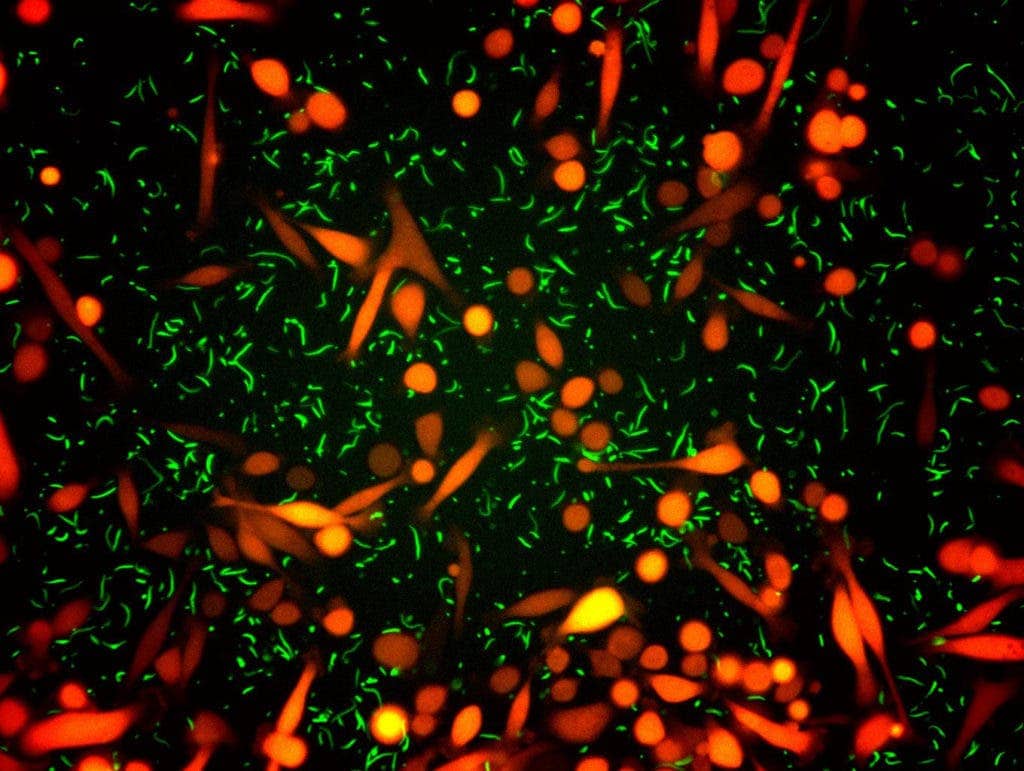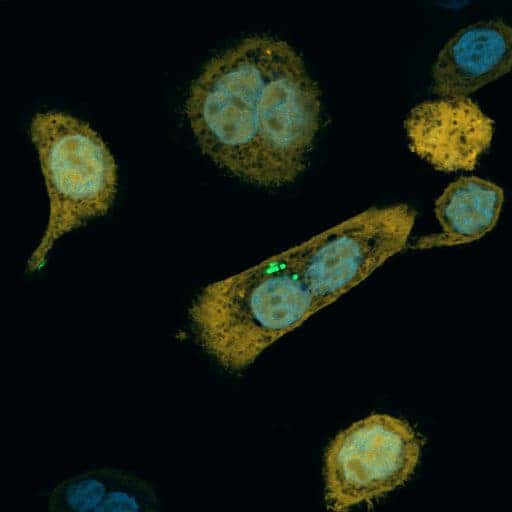Chemo-resistant cancers may be getting help from a shady source: bacteria. The good news is that an antibiotic cocktail can eliminate this resistance, and put tumors back in the crosshair.

Image credits Geller et al., 2017.
A team of researchers, led by Dr. Ravid Straussman from the Weizmann Institute of Science’s Department of Molecular Cell Biology, caught an intrepid band of bacteria in the act of safeguarding cancer cells from treatment. The name of these villainous rogues? Mycoplasma hyorhinis.
The findings help explain why some otherwise-treatable cancers can shrug off powerful therapies.
Bacterial garrisons
According to the authors, drug resistance among cancers is a “foremost challenge” to our treatment efforts, but their findings offer hope that — at least certain types of drug-resistant cancers — could become treatable simply by mixing in antibiotics with chemotherapy regimens. However, the results are based on animal and lab experiments that haven’t yet been replicated or confirmed in human cancer cases. Even if the method proves to be effective, it will still take some time before it’s turned into new practices available for patients.
The team started their research after noticing that growing certain types of cancer cells together in the lab caused them to become resistant to gemcitabine, a widely-used chemotherapy compound. That was definitely a problem, since gemcitabine is used to treat pancreatic, lung, breast, as well as bladder cancers — this acquired immunity would thus pose a huge threat for a lot of patients.
Their first theory was that some of the cancerous cells produced a drug-canceling molecule that would inadvertently protect their neighbors as well. So the team tried straining the culture and then testing the surrounding liquid to see if they can identify said molecule. Instead, what they found was that the cultures lost their immunity after the liquid was pumped through a relatively large filter of 0.45 micrometers — which would catch large bodies like bacteria, but not chemical compounds.
All in all, this meant that the cells weren’t using a type of chemical defense. Upon further inspection, the team noticed that some of the cells in their cultures were contaminated with M. hyorhinis, which could metabolize gemcitabine into harmless compounds. To test if M. hyorhinis was indeed causing the cells’ drug resistance, they then transplanted treatable cancer cells into mice — some contaminated and some not. Subsequent treatment revealed that bacteria-bearing tumors had become unresponsive to gemcitabine.
Gamma protect-o-bacteria

Image credits Geller et al., 2017.
Ultimately, the team traced the bacteria’s resistance to a gene called CDDL, which encodes gemcitabine’s metabolic pathway, i.e. the mechanisms used to counter it. More worryingly, the team reports that CDDL is quite common in other bacteria as well. Out of the initial batch of 27 bacteria species they tested, 13 could process gemcitabine. After broadening their search (using genetic databases containing the genome of some 2,700 bacterial species,) they found several hundred other species that posses the CDDL gene. Most of them are part of the Gammaproteobacteria class, a huge tree of bacteria which includes E. coli and Salmonella.
To see how much of a problem this huge population could pose for humans, the researchers assembled 113 cell samples of human pancreatic cancers (pancreatic ductal adenocarcinoma) collected during cancer surgeries, and 20 samples from organ donors that had healthy, cancer-free pancreata. Out of the first group, 86 samples showed signs of bacterial contamination (mostly Gammaproteobacteria), and only 3 in the second group did the same. The team believes these bacteria move to invade pancreatic tumors from the duodenum, the first part of our intestines.
Finally, the team engineered an E. coli strain that carries the CDDL gene — as opposed to the CDDL variant — and injected it into the tumor-carrying mice. They also used fluorescent marker molecules to keep track of what the tumors and bacteria were up to. Finally, they treated them with either gemcitabine and antibiotics or just gemcitabine. In the first group’s case, the bacteria disappeared and their tumors shrank. For the gemcitabine-only group, the tumors persisted and progressed rapidly.
Overall, the results “merit additional exploration,” the authors conclude.
The paper “Potential role of intratumor bacteria in mediating tumor resistance to the chemotherapeutic drug gemcitabine” has been published in the journal Science.


